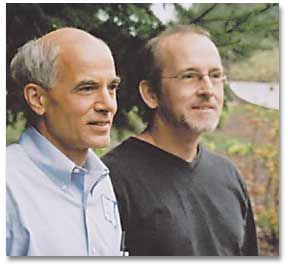|
COVER STORY | IN THE NEWS | DIRT | ARTBEAT October 19, 2006
HBGF's Annual Speakers Symposiumby AMY STEWART Every year, the Humboldt Botanical Gardens Foundation organizes a horticultural symposium and brings an impressive group of speakers together for a day. It's the kind of event that always makes me realize that, for such a small area, we really do have quite a lot going on. This year, the topic is "People and Plants: Pleasures & Pains from Plants" and the speakers will focus on three plants that, to some extent, hold power over people: tobacco, cacao (chocolate) and mushrooms.
Left: Professors Jeff Hogue and Daniel Harder (left to right). Photo by Karen Angel If you've grown tobacco, you know that it can really move. "I planted some in my garden," Harder told me, "and I knew it would re-seed, but I didn't expect to see it down the street." He took a shovel over to the neighbor's house, explaining that his flowers had run away from home and he'd like to have some back. But tobacco doesn't just travel down the street -- it travels around the world, influencing people, for better or for worse, wherever it goes. Harder is fascinated with the history of tobacco and plans to talk about its early history as a Native American plant that was quickly adopted by Europeans. He's also quick to point out that the form of tobacco most familiar to us -- cigarettes -- is surprisingly far removed from the plant itself. "Some people still think that when they smoke a cigaratte, they're smoking a leaf, you know?" Harder said. "Like it's a natural product of some kind. Not at all." Harder conducted a series of tests on cigarettes for the FDA in which he worked out how cigarattes are manufactured and dosed with nicotine. "This is a highly processed product," he said. "What they're doing is taking stems and woody material from the tobacco plants and chopping it up to make a really thin product kind of like particle board, and then they spray that with their proprietary tobacco juice, which contains more nicotine." Under a microscope, he could determine what varieties of tobacco were being used simply by examining the fine hairs on the plant fragments. He proved that nicotine levels were highly manipulated so that each pack contained identical levels, a feat that would have been impossible without some artificial manipulation. In spite of its shady history, Harder respects the plant for its more useful qualities. Nicotine is a natural insecticide that evolved to protect the plant, and organic farmers use a tea made of nicotine leaves to break the growth cycle of caterpillars and stop infestations. He also points out that tobacco has medicinal properties -- when applied to the skin, a leaf can staunch blood flow or help draw out snake venom. Tobacco is useful in another, more unexpected, way: as a teacher. "The fact is that most of the best early plant science was done on tobacco, because tobacco companies have always had the money to do that work," Harder said. "We've learned an incredible amount about botany from tobacco." In addition to Harder's talk, you'll get to hear a talk from Jeff Hogue, who teaches courses on natural history at College of the Redwoods, on "Chocolate: Food of the Gods," and David Lee Largent, Professor Emeritus of Botany at HSU, will discuss "Fungi of the Redwood Forests." HBGF's annual symposium takes place on Saturday, November 4 from 9-3 at the Humboldt Area Foundation, 373 Indianola Road, in Bayside. Although the event is designed to be entertaining and informative for just about anybody, if you are a Master Gardener you can get five hours of continuing education credit. Registration is $25 for members and $30 for non-members, and that includes a pasta lunch from Roy's. To register, call HBGF at 442-5139. Funds go to support HBGF and their 45-acre botanical garden, which is under construction now at College of the Redwoods.
Send garden news to amystewart@northcoastjournal.com, or write in care of the Journal at 145 G St., Suite A, Arcata, 95521. COVER STORY | IN THE NEWS | DIRT | ARTBEAT Comments? Write a letter! © Copyright 2006, North Coast Journal, Inc. |


 I
spoke to Daniel Harder, Executive Director of the Arboretum at
the University of California, Santa Cruz, about the talk he'll
be giving at the symposium, "Tobacco -- Timeline and Culture."
If you're a gardener, you may already know tobacco as an ornamental
garden plant. Several species of Nicotiana flower and
re-seed in ordinary garden soil; Annie's Annuals' Nicotiana
langsdorfii is often available in nurseries around town and
is popular for its tubular lime green flowers and its willingness
to grow in sun or shade.
I
spoke to Daniel Harder, Executive Director of the Arboretum at
the University of California, Santa Cruz, about the talk he'll
be giving at the symposium, "Tobacco -- Timeline and Culture."
If you're a gardener, you may already know tobacco as an ornamental
garden plant. Several species of Nicotiana flower and
re-seed in ordinary garden soil; Annie's Annuals' Nicotiana
langsdorfii is often available in nurseries around town and
is popular for its tubular lime green flowers and its willingness
to grow in sun or shade.